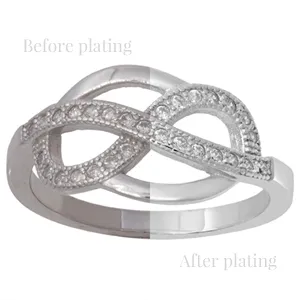Rhodium plating
Rhodium is a precious metal – like gold, silver, or platinum – only more expensive! In fact, it is the most expensive of all the precious metals. Why is that? Well, because it is very rare in nature, it is only found as a by-product of mining for other metals, such as platinum.

Some interesting things about rhodium.
Bright white and protective!
Rhodium plated jewellery adds an extra layer of protection to jewellery and produces a brighter white than sterling silver, white gold, or platinum. Realistically, jewellery cannot be crafted from solid rhodium because, despite its strength, rhodium is brittle. A layer of rhodium plating must be just the right thickness to keep it from cracking–.75-1.0 microns is perfect. Any thinner and the metal underneath would show; any thicker and the coating would crack. That perfect layer of rhodium can enhance the appearance, quality, and longevity of your jewellery.
All white gold, is essentially an alloy of pure (24ct) yellow gold, so it is natural to assume that it has a yellow tinge. The rhodium plating is a process which gives the white gold its ultra white colour by placing a coating over the existing metal.
Most white gold jewellery in the commercial market is actually rhodium plated. If your “white gold” jewellery is lustrous silver, then it probably has a layer of rhodium. If it has a light yellow tinge then it’s likely true white gold. But owning rhodium plated white gold is not bad–the rhodium coating increases the value and durability. You will just have to prepare for some maintenance to retain that reflective shine.
Solid white gold isn’t white but slightly yellow. Rhodium plating white gold gets rid of the yellow tinge. Different shades of gold come from alloying or combining metals.
Rhodium is plated using an electroplating process. For a piece of jewellery to be plated, it must first be thoroughly cleaned to remove all contaminants. If there is any dirt on the piece, the plating will not hold.
Distilled water, steam cleaning and electro cleaning are some ways that the item is cleaned before it is dipped into the rhodium solution. A positive electrical charge is then used to fuse the rhodium onto the base metal.
While it is permanent, like any other metal used in jewellery, it tends to suffer wear and tear with exposure.
Rhodium plating wears off over time and will need to be re-plated. Typically, a ring would need to be re-plated once every 12 to 18 months, but this can vary depending on the wear and tear the piece sustains as well as the thickness of the plating and the colour of the base metal.
Sometimes the body chemistry of the wearer is also a factor that can affect how quickly the plating wears off. If the base metal is yellowish, there is a high chance that the colour will bleed through before the 12 months is up.
How to make rhodium plating last longer.
Rhodium plating is bound to wear off after a while, but there are some steps you can take to make it last as long as possible.
- Avoid rubbing the rhodium plating on your ring. For example, constantly washing your hands can wear it off quicker.
- Avoid exposing your jewellery to harsh chemicals. Always take off your jewellery when dealing with chemicals or wear rubber gloves to protect your rings.
- Take your jewellery off when swimming in heavily chlorinated pools as the chlorine can damage the plating.
- Perfumes and cosmetics can also affect rhodium plating. Avoid contact with these and wipe away any residue if it does come into contact.
PROS OF RHODIUM PLATING
- Beautiful
- Durable
- High-quality
- Hypoallergenic
- Non-toxic
CONS OF RHODIUM PLATING
- Some maintenance required
If the maintenance does not appeal to you and you want to invest in an heirloom piece, then shop for platinum or 14 carat white gold jewellery.